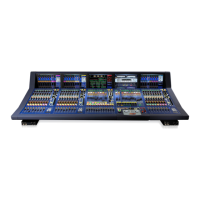XL8 compressor modes (dynamic) 273
XL8 Control Centre
Operator Manual
More (output compressors only)
The compressors are capable of producing very subtle and natural sounding
compression primarily because of special, sonically developed, algorithms. The MORE
switch disables these, in order to generate aggressive compression artefacts for effects
purposes.
Gain
The gain control provides adjustment of the make up gain so that the level of the
outgoing compressed signal can be matched to the incoming uncompressed signal. It
can also be used to drive the clipper hard (see “Soft clip level” on page 273) to produce
more pronounced effects.
Side chain filter
A band pass filter is provided that acts on the side chain signals. This can be used to
make the compression frequency selective. The controls for this are frequency,
adjustable from 40Hz to 16KHz, and bandwidth selectable as wide medium or narrow.
Additionally, there is a listen function that places the filtered side chain onto the solo
bus and a side chain filter in to activate or eliminate the filter action.
Soft clip level
When compression is used creatively with slower attack times, it is possible to generate
very large peak signals that can eat up headroom. When soft clip is activated the
compressor output (post make up gain) is fed through a final fast acting soft clipper
circuit. This adds progressive gain reduction to any signals that exceed a threshold set
by the clip level control. When set sparingly this can recover 3dB to 6dB of headroom
without introducing any undesirable audio artefacts. (In the past, limiters have been
employed for this function but their time constants are invariably intrusive on the
programme.) The high-speed nature of the soft clipping introduces no time related
artefacts. This is because it only acts during the transient peaks, when it produces
predominantly third harmonic distortion, which is very musical in nature.
Compressor envelope modes
The five envelope modes, or signatures, are the key to the sonic character of the XL8
compressors, and they allow adjustment far beyond the normal capabilities of simple
attack and release settings. They largely fall into two application types:
1 Compressors that are good at capturing and controlling dynamic transients:
corrective mode and vintage mode.
2 Compressors that emphasise dynamic transients and provide creative control of
levels within a mix: adaptive, creative and shimmer modes.
The Vintage and Adaptive compressors tend to morph a little between these two
categories depending on threshold control settings. This makes them easy to use
intuitively with minimal fine-tuning of the envelope control settings.
Further refinement and enhancement of the envelope modes is provided by
combination settings of the three-position KNEE switch and the MORE switch. It is
best to understand the operation of these two functions in more depth before looking at
the detail of the compressor signature switching.

